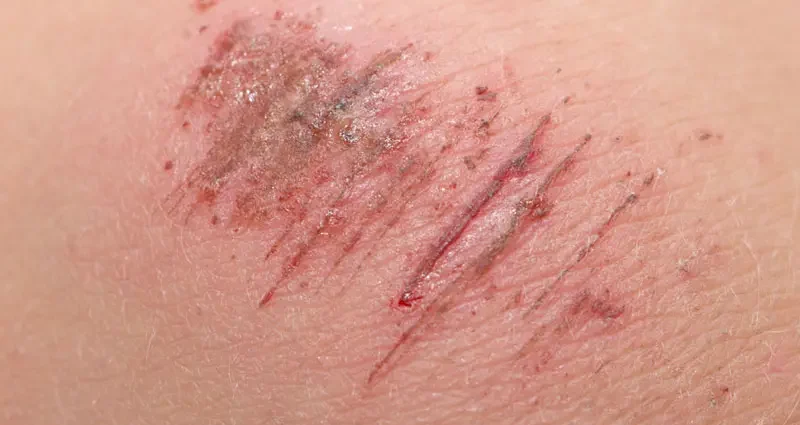Contents
Superficial violations of the integrity of the skin, which affect only the upper layers, are called abrasions. Usually, abrasions “wet” rather than bleed, since the capillaries are not badly damaged. Pinkish or yellowish lymph is released, there is no severe bleeding with such wounds. The surrounding skin may swell and turn pale.
Sometimes outwardly it is difficult to distinguish an abrasion from a small wound. After healing, abrasions almost never leave scars, unlike wounds.
Abrasions are usually caused by strong friction on some surface, for example, when falling on asphalt or scratching the skin with your nails. The area of damage can be very large, and although abrasions are not a dangerous wound, the risk of infection is high. Such an injury causes a burning sensation and pinching of the skin, since there are many nerve endings in the upper layers of the skin.
First aid for abrasions
The first protective film on the abrasion appears only after a few hours. Up to this point, the wound is actively getting wet, and it is at this time that it is important to properly treat the damage.
Bacteria can get into an open abrasion, which can cause further inflammation. If the fall was on the ground, it is even possible to become infected with tetanus – a dangerous infection.
First of all, the one who will provide assistance should treat their hands with an antiseptic or wear gloves. Otherwise, you can bring a new infection into the wound.
Next, you need to wash the abrasion with clean boiled water with antibacterial soap. If this is not available, you can use hydrogen peroxide, a weak solution of potassium permanganate or furacilin. Do not pour alcohol or similar liquids directly onto the wound.
After wetting the surface of the abrasion with a clean cloth, the edges of the wound must be treated with a solution of iodine or brilliant green. It is not necessary to smear the damaged skin itself, only around it. If the abrasion is large, you can cover it with a sterile bandage. It is enough to close a small wound with adhesive tape, and then only for the first time, until the surface dries. Abrasions heal better with air access, so many layers of dressings are not needed.
Then you can go to a medical facility to administer tetanus toxoid. This is necessary if the earth got into the wound or the person was not vaccinated with tetanus. Do not neglect this, although it is hard to believe that such a small abrasion cannot lead to serious consequences.
Types of abrasions
Abrasions are extensive, they are clearly visible externally and are formed by rubbing a sufficiently large area of skin against the surface. It is possible to get a narrow abrasion if the damage is caused by the narrow end of sharp objects.
The first hours the surface of the abrasions is pinkish-red and constantly wet. There is swelling and swelling around the wound. Gradually, the abrasion dries up, a crust forms, which protects the wound, the swelling subsides.
New skin begins to form under the crust, so it is important not to tear off the scab, even if the edges have begun to peel off. The crust falls off after about a week or more, the skin underneath will be pinkish and shiny for a while.
Effective ways to heal abrasions
With proper primary treatment of abrasions, such wounds heal quite quickly. If the damaged surface is small, then it is better not to bandage it at all. The main thing for healing an abrasion is the access of air, which dries the ichor.
If necessary, a bandage should be applied across the abrasion so as not to stretch the skin, but rather to bring the edges of the wound closer together. You do not need to apply a bandage immediately after receiving an abrasion – for the first hours it will get wet, and the bandage will simply stick to the skin. The bandage is removed quickly enough, it is not kept for a long time.
If infection has been avoided, the abrasion will heal on its own within a maximum of two weeks and will not leave scars. If suppuration has begun, the edges become very inflamed, fluid is released and the pain does not stop for more than a day. How to treat an abrasion in this case?
The abrasion is re-treated with antiseptics, washed (for example, with chlorhexidine). The edges of the abrasion are re-lubricated with iodine or brilliant green. Next, special antibacterial ointments are applied and covered with a sterile napkin. The bandage is changed every few hours until the symptoms of inflammation subside. After such complicated healing, small scars sometimes remain.
Popular questions and answers
Properly rendered first aid for abrasions is a guarantee of their quick and successful healing. About what to do with such an injury, tells surgeon, Head of the Department of Purulent Surgery, GKB them. V.V. Vinogradova, Candidate of Medical Sciences, laureate of the Moscow city award in the field of medicine Dmitry Romashov.
Is it possible to treat abrasions with folk remedies?
What to do if the abrasion oozes?
If the abrasion began to ooze after a while after drying, it may be suppuration. In this case, you can apply a bandage with Levomekol ointment and show the wound to the doctor. The use of well-known Vishnevsky ointments, ichthyol and other fat-based ointments is not recommended. They prevent the outflow of pus from the wound. It is also undesirable to use antiseptic solutions with a strong odor, for example, Chlorophyllipt solution.










